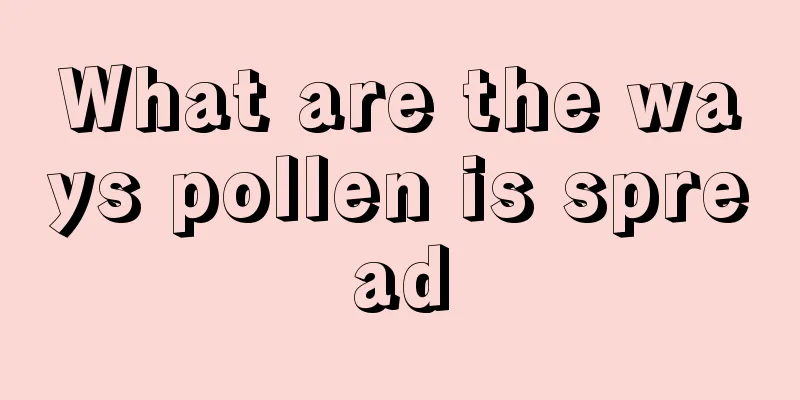What are the ways pollen is spread

|
As we all know, flowers not only satisfy people's desire to appreciate, but are also a good way to express feelings. Whether it is a confession of love or visiting a patient, most people will choose to buy a bouquet of flowers. Different flowers have different meanings. Flowers seem beautiful and colorful, so how do they spread pollen? Let's follow the editor to learn in detail about the way flowers spread pollen. Pollination is an indispensable part of plant sexual reproduction, and it occurs in two ways: self-pollination and cross-pollination.Self-pollination: pollen from the stamen is transferred to the stigma of the same flower. Self-pollinating plants must have bisexual flowers, but plants with bisexual flowers do not necessarily self-pollinate, but are more likely to cross-pollinate. Soybeans, peas, barley, wheat, sesame, etc. are all self-pollinating. Cross-pollination: Pollen from one flower is transferred to the stigma of another flower on the same plant, or pollen from one flower is transferred to the stigma of another flower on a different plant. Cross-pollination is more evolved than self-pollination because during self-pollination, the genetic differences between the reproductive cells of the male and female are smaller. Continuous self-pollination will cause the vitality of the offspring to decline. At present, there are still self-pollinating plants in nature. This is an adaptation phenomenon formed during the evolutionary process and is related to the reproduction of offspring. When conditions are not suitable for cross-pollination, plants can complete the reproduction process through self-pollination. Most plants in nature are self-pollinating, but some individuals are cross-pollinating. Self-pollination protects the pollen from some damage, such as being eaten by insects. Self-pollinating plants have stable characteristics. Cross-pollination of plants requires the help of external forces. The media for transmitting pollen include wind, insects, birds and even water. The most common are wind and insects. The offspring produced by cross-pollination have stronger vitality and adaptability. This is because the males and females are in different environments and have large genetic differences between them. During the evolution process, cross-pollination was gradually selected and developed, becoming the pollination method of most angiosperms. The transport of pollen by wind is called anemophily. Most Poaceae plants are wind-pollinated, such as poplar, oak, birch, etc. Their flowers are called wind-pollinated flowers. The perianth of wind-pollinated flowers is not prominent, has no bright colors, no fragrance or nectar glands, and cannot attract insects to help, but their pollen is dry, light, and abundant, making it easy to be blown by the wind, thus ensuring more opportunities for pollination. The filaments of the stamens of Poaceae plants are relatively long, and the anthers hang outside the flowers and can be spread by the wind. These swaying inflorescences and anthers are an adaptation of wind-pollinated plants to wind pollination. In order to increase the chance of receiving pollen, the stigma of the pistil of wind-pollinated flowers is significantly expanded and prominent. The method of transferring pollen with the help of insects is called insect pollination, and flowers that are pollinated by insects are called insect-pollinated flowers. Insect-pollinated flowers generally have brightly colored perianths, aromatic odors, and nectar. The pollen of insect-pollinated flowers is larger in size and has a rough surface, making it easier for insects to carry it. |
<<: The role of bleaching block in food
>>: Is the mosquito killer lamp harmful to babies?
Recommend
What are the main causes of prostate cancer in boys?
Prostate cancer is a disease that most male frien...
The area around the buttocks is burning and painful
If we often feel a burning pain around the buttoc...
What to do if the inside of the right shoulder blade hurts
When the shoulder blade is in one posture for a l...
What causes coughing with white phlegm? Mostly lung heat
If the patient has a cough with white sputum, it ...
What are the obvious symptoms of pleurisy
Pleurisy is a relatively common disease. In recen...
What kind of diet should lung cancer patients pay attention to?
Lung cancer has less impact on the digestive syst...
What sleeping posture can help you lose weight on your legs at night
Most women who want to slim down their legs actua...
What causes breast pain at 60?
For female friends, no matter at what age, they s...
Something wrong with your face? The culprit turned out to be the computer and the mobile phone
Many people sit in front of computers all day at ...
TCM Syndrome Differentiation and Treatment of Laryngeal Cancer with Phlegm Accumulation
Traditional Chinese medicine advocates the treatm...
What are the mid-term symptoms of esophageal cancer
Symptoms of esophageal cancer in the middle stage...
Will gastroenteritis cause heartburn?
Many people who like to eat cold and spicy food a...
What to do if fish sticks to the pan
Fish is a kind of meat we often eat. Compared wit...
How to treat dry and itchy nose in winter
In winter, the wind is stronger and the air is dr...
What are the main causes of prostate cancer
Although the cause of prostate cancer is still un...









